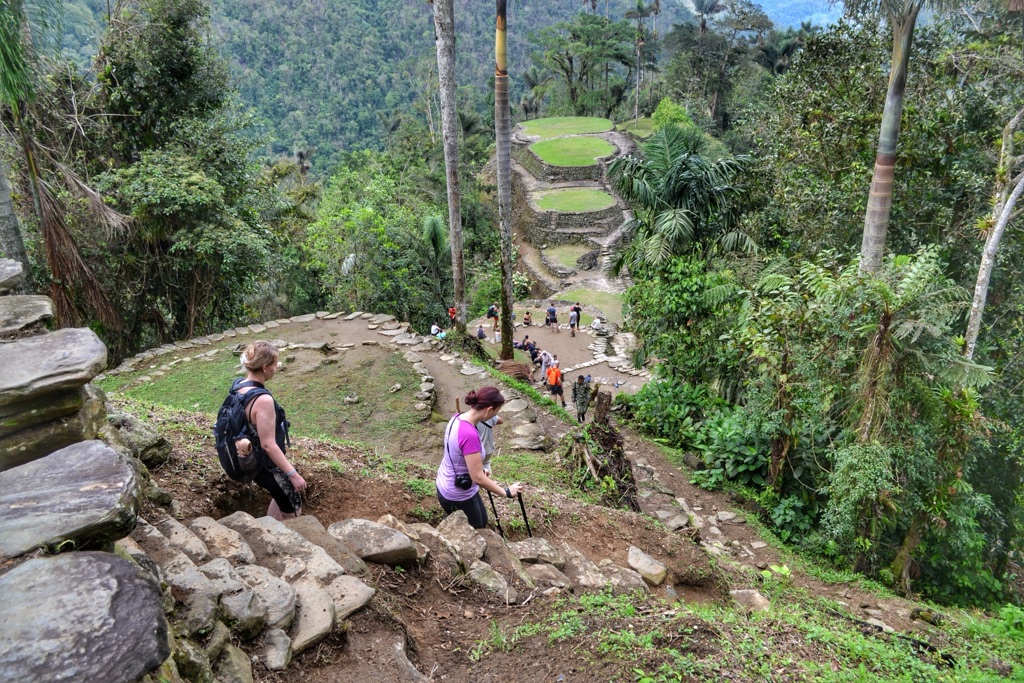Ciudad Perdida, which translates to “Lost City,” is an ancient archaeological site located in the Sierra Nevada de Santa Marta mountains in Colombia. Believed to have been founded around 800 AD, it predates the famous Machu Picchu by several centuries. The city was rediscovered in 1972 when a group of local treasure looters found a series of stone steps rising up the mountainside. They named the city “Green Hell” or “Wide Set.” It was later known as Ciudad Perdida after the Colombian government took over the site. The city was built by the Tairona people and was a major hub of their civilization. It consists of over 169 terraces carved into the mountainside, a network of tiled roads, and several small circular plazas. The site was abandoned during the Spanish conquest, and it remained hidden for centuries.
Get your dose of History via Email
Historical Background of Ciudad Perdida
The Lost City, or Ciudad Perdida, was built by the Tairona people around 800 AD. It served as a major political and economic center for the civilization. The Tairona inhabited the region until the Spanish conquest in the 16th century. After the conquest, the city was abandoned and reclaimed by the jungle, remaining undiscovered for centuries. In 1972, treasure hunters stumbled upon the site, leading to its rediscovery. The Colombian government soon declared it a protected area.
Archaeologists believe that Ciudad Perdida was one of the most important cities of the Tairona civilization. It was likely a hub for trade, politics, and religion. The city’s layout suggests it had a hierarchical society. The higher terraces were probably home to the ruling class, while the lower ones housed the common people. The Tairona were known for their expertise in stone construction, which is evident in the ruins.
After its rediscovery, Ciudad Perdida underwent extensive archaeological excavations. These revealed a complex network of plazas, houses, and ceremonial centers. The site was opened to tourism in the 1980s. However, it was closed in the early 2000s due to guerrilla activity in the area. It reopened in 2005 and has since become a popular trekking destination.
The city’s history is not without conflict. It was the scene of battles between the Tairona and the invading Spanish forces. The Tairona resisted the Spanish, but eventually, the city was abandoned as the Spanish took control of the region. The city’s rediscovery also sparked a wave of looting. The Colombian government has since worked to protect and preserve the site.
Today, Ciudad Perdida is recognized as an important part of Colombia’s cultural heritage. It offers insights into the Tairona civilization and their way of life. The site continues to be studied by archaeologists, who hope to learn more about the pre-Columbian history of the Americas.
About Ciudad Perdida
Ciudad Perdida is an impressive example of pre-Columbian engineering and architecture. The city is built on a series of terraces carved into the mountain. These terraces were used for agriculture and as foundations for buildings. The site covers an area of about 2 square kilometers and is accessible only by foot.
The construction methods of Ciudad Perdida reflect the Tairona’s advanced understanding of their environment. They built retaining walls to prevent erosion and managed water through a series of channels. The city’s buildings were made of stone and wood, with thatched roofs. The main materials used were local stones, clay, and wood from the surrounding forest.
One of the architectural highlights of Ciudad Perdida is its network of stone-paved roads and bridges. These connected the various parts of the city and extended to other Tairona settlements. The roads are a testament to the Tairona’s skill in urban planning and construction.
The city also features several circular plazas, which were likely used for social and ceremonial purposes. The largest plaza may have been the site of major community gatherings or rituals. The plazas are interconnected by the road system, indicating a well-thought-out urban design.
Despite the passage of time, many of the site’s structures remain in good condition. This durability is a testament to the Tairona’s building skills. The site continues to be an important focus of archaeological study and conservation efforts.
Theories and Interpretations
Several theories exist about the use and significance of Ciudad Perdida. Most archaeologists agree that it was a center of Tairona civilization. It likely played a key role in regional trade networks, politics, and religion.
Some theories suggest that Ciudad Perdida was a ceremonial center. The layout of the plazas and the alignment of the structures may indicate astronomical or religious significance. The Tairona may have used the city for rituals and as a gathering place for important events.
There are mysteries surrounding Ciudad Perdida, including the exact reasons for its abandonment. While the Spanish conquest is a likely factor, some believe that disease or internal conflict may have contributed. The city’s isolation has preserved many of its secrets, which archaeologists are still trying to uncover.
Historical records from the Spanish conquest provide some context for interpreting the site. However, much of the Tairona’s written history was lost during the colonial period. This has made it challenging to match the archaeological findings with historical accounts.
Dating of the site has been carried out using various methods, including radiocarbon dating. These studies have helped establish the timeline of the city’s occupation and its peak period. The dating also confirms that Ciudad Perdida predates many other known pre-Columbian sites in the Americas.
At a glance
Country: Colombia
Civilization: Tairona
Age: Founded around 800 AD
Conclusion and Sources
Reputable sources used in creating this article:
- Wikipedia: https://en.wikipedia.org/wiki/Ciudad_Perdida

